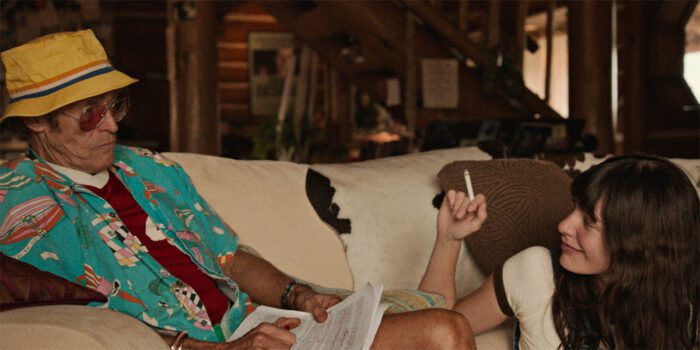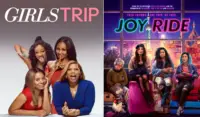Gonzo journalism is a type of journalistic writing that isn’t entirely concerned with objectivity or the elimination of bias. Instead, the writer is free to include their own thoughts, opinions, and emotions to paint a fuller picture of what they’ve been sent to cover. The undisputed king of gonzo journalism is Hunter S. Thompson, who wrote about his experience at the 1970 Kentucky Derby. This piece is considered to be the beginning of this type of writing, which explains why a thinly veiled version of Hunter S. Thompson is one of the main characters in Patricia Arquette’s directorial debut, Gonzo Girl.
The film is adapted from Cheryl Della Pietra’s semi-autobiographical memoir about her time as Hunter S. Thompson’s assistant. No longer in his prime, the Thompson stand-in, Walker Reade (Willem Dafoe), is coasting on the fame of his old books. All his money is being spent on drugs, alcohol, and entire menus at restaurants. It’s the ’90s and his publisher expects one last book out of him. His secretary (Arquette) is far too old and far too tired to try her hand at wrangling Walker into writing when his priorities lie elsewhere. That elsewhere includes the aforementioned drugs and alcohol, as well as sleeping with his much younger girlfriend (Elizabeth Lail).
That’s where Alley (Camila Morrone) comes in. She’s a recent college graduate from New York City who dreams of writing. The thought of being Walker’s assistant is appealing. It’s an opportunity to work hand in hand with one of the most prolific writers of the century and learn from him. Almost immediately, though, Alley realizes that this job is more like babysitting than anything else. With the ever-looming deadline and the realization that she only gets paid if Walker finishes a book, Alley takes matters into her own hands. She begins to secretly rewrite his novel.

It’s always interesting to watch actors with storied careers take their first stab in the director’s chair. The film is often personal, even if the actor didn’t write the script. Gonzo Girl seems to fall in line with this tradition, allowing Arquette to express deeply important themes through a new medium. She examines themes like addiction, coming of age, and womanhood. It’s clear that the years she has spent in the industry have created a stylistic voice within her. Panache and thoughtfulness are visible in her direction. Her clear vision of composition and blocking produces some stunning visuals. Maybe it’s the result of her self-described shoestring budget, but there’s a strong directorial voice within Arquette. The drug sequences are exhilarating blends of animation born of the inability to afford a VFX team. The same can be said of Arquette’s inventive means of creating the illusion of walking spaghetti in one of the drug scenes.
Perhaps Arquette’s keenest directorial attribute is in her casting. Not many would think to pair Morrone and Dafoe, but Gonzo Girl shows that they’re an utter dream team. At times the two are at odds with each other, bickering to no end in this delightful, odd-couple way. At other times there’s a more nuanced tension between them. It’s deeper than mentor/mentee or boss/assistant, and filled with admiration, hatred, attraction, and animosity. There’s also a scene involving a clove of garlic that will set the internet ablaze. The two actors are comparable sparring partners. This is something new for Marrone, whose breakout role was in Prime Video’s Daisy Jones & the Six. It’s Dafoe, not at his weirdest (because that bar is simply too high), but clearly enjoying his turn as a strange, complex writer.
If the team of Morrone and Dafoe is Arquette’s ace in the hole, then the script is her Achilles heel. Some of the characterization is confusing, especially Alley’s goody-two-shoes personality almost immediately caving to Walker’s drug-fueled lifestyle. The plot feels a bit aimless, much like Walker’s writing process, but Dafoe and Morrone are impossible to look away from. They hold down this flyaway script with so much confidence and charm that even though there’s much more to be desired in terms of thematic development, it’s a wild ride to be part of. A ride that must be seen through to the end. Gonzo Girl marks a strong debut from Arquette, and watching her grow as a director will be a thrill. This film is a showcase of its talented leads, but a little light on substance.



